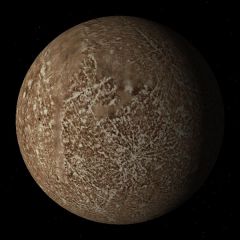Difference between revisions of "Mercury"
m |
(Updated description.) |
||
| Line 50: | Line 50: | ||
| − | Mercury is the | + | '''Mercury''' is the smallest planet in the [[solar system]] and is the closest to the [[Sun|sun]]. The orbital period is 87.975 days. The rotation of Mercury is tidally locked with the sun in a 3:2 spin-orbit resonance. So, an observer on Mercury would see one solar day every two Mercurian years. Mercury's axial tilt is only about <sup>1</sup>/<sub>30</sub>°, and its orbital eccentricity is the largest of the eight planets at 0.20563. |
| − | + | Mercury is a rocky planet appearing much like the [[Moon|moon]] and has virtually no atmosphere (none is modeled in Orbiter), and has no natural satellites. | |
| − | + | ||
| − | + | Mercury was visited in 1974 and 1975 by Mariner 10 in two flybys and was again visited by MESSENGER spacecraft orbiting Mercury from 2011 to 2015 when it was deorbited. There is a plan for the BepiColombo spacecraft to visit in 2025. | |
| − | |||
| − | |||
==Add-ons== | ==Add-ons== | ||
Revision as of 11:27, 12 June 2021
Mercury is the smallest planet in the solar system and is the closest to the sun. The orbital period is 87.975 days. The rotation of Mercury is tidally locked with the sun in a 3:2 spin-orbit resonance. So, an observer on Mercury would see one solar day every two Mercurian years. Mercury's axial tilt is only about 1/30°, and its orbital eccentricity is the largest of the eight planets at 0.20563.
Mercury is a rocky planet appearing much like the moon and has virtually no atmosphere (none is modeled in Orbiter), and has no natural satellites.
Mercury was visited in 1974 and 1975 by Mariner 10 in two flybys and was again visited by MESSENGER spacecraft orbiting Mercury from 2011 to 2015 when it was deorbited. There is a plan for the BepiColombo spacecraft to visit in 2025.
Add-ons
- Mariner 10 - Historically the first probe to use gravitational assists and first probe to visit Mercury. It made three fly-by's of Mercury between November 1973 and March 1974, but did not enter orbit. This probe is modeled in Orbiter in an add-on made by user "missleman01": GEP - Mariner 10 [1]
- MESSENGER - Historically the first probe to enter orbit around Mercury. After three fly-by's between January 2008 and September 2009, it entered an highly elliptical orbit around Mercury on March 18th, 2011. This probe is modeled in Orbiter in several add-ons [2]
- Mercury Level 9 Textures at Orbit Hangar The texture was created using mosaics of the planet Mercury with pictures taken by the MESSENGER spacecraft in 2011
References
External links
- Mercury at Wikipedia
- Mariner 10 mission at Wikipedia
- MESSENGER mission at Wikipedia
| edit The Solar System | |
|---|---|
| Central star |
Sun (Sol) |
| Planets |
Mercury - Venus - Earth - Mars - Jupiter - Saturn - Uranus - Neptune |
| Natural satellites |
Moon - Phobos - Deimos - Io - Europa - Ganymede - Titan - more... |
| Add-ons |
Planets - Dwarf Planets - Small objects - Natural satellites - Alternative star systems |
 | This article, about a planet, is a stub. You can help Orbiterwiki by expanding it. |
